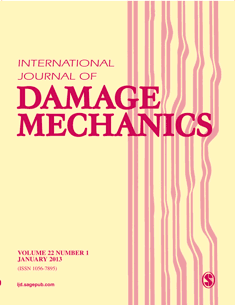
INTERNATIONAL JOURNAL OF DAMAGE MECHANICS
Scope & Guideline
Shaping the Future of Mechanical Engineering
Introduction
Aims and Scopes
- Damage Mechanisms in Materials:
Research on the fundamental mechanisms through which materials degrade, including fatigue, creep, and fracture. This includes studies on metals, polymers, composites, and rocks. - Modeling and Simulation Techniques:
Development and application of advanced theoretical and numerical models for predicting damage evolution and material behavior under various loading conditions. - Experimental Investigations:
Empirical studies aimed at understanding damage processes through experimental methods, including acoustic emission, digital image correlation, and mechanical testing. - Multiscale Approaches to Damage Analysis:
Integration of microstructural analysis with macroscopic behavior to provide a comprehensive understanding of damage phenomena in heterogeneous materials. - Applications in Engineering and Geosciences:
Exploration of damage mechanics in practical applications, such as civil engineering, aerospace, and geological engineering, focusing on real-world implications and solutions.
Trending and Emerging
- Self-Healing Materials:
The exploration of self-healing mechanisms in materials, particularly in cementitious composites and polymers, is gaining traction as researchers aim to develop more durable and sustainable materials. - Multiscale Modeling Techniques:
There is a growing emphasis on multiscale modeling that connects microstructural behavior to macroscopic material performance, enabling more accurate predictions of damage evolution. - Hybrid and Composite Materials:
Research into the damage behavior of hybrid and composite materials is on the rise, reflecting industry trends towards lightweight and high-performance materials in aerospace and automotive applications. - Machine Learning and AI in Damage Prediction:
The application of machine learning and artificial intelligence for predicting damage and optimizing material performance is emerging as a significant trend, leveraging big data to enhance traditional modeling approaches. - Environmental Effects on Damage Mechanisms:
Increased focus on how environmental factors, such as temperature fluctuations and moisture content, influence damage mechanisms, particularly in geological and construction materials.
Declining or Waning
- Traditional Concrete Damage Models:
While concrete remains a key area of research, traditional models that do not incorporate advanced computational techniques are becoming less relevant as newer methodologies gain traction. - Single-Material Focus:
Research that focuses solely on the damage mechanisms of single materials, without considering composite or hybrid systems, is becoming less frequent as the field moves towards more integrated approaches. - Static Load Testing:
Studies relying exclusively on static load testing are decreasing as dynamic loading scenarios, including impact and fatigue under variable conditions, are increasingly recognized for their real-world applicability.
Similar Journals
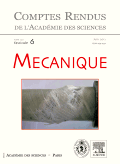
COMPTES RENDUS MECANIQUE
Advancing the Frontiers of Mechanics and Materials ScienceCOMPTES RENDUS MECANIQUE, an esteemed journal published by the Académie des Sciences, serves as a critical platform for cutting-edge research in the fields of mechanics and materials science. With an ISSN of 1631-0721 and an E-ISSN of 1873-7234, this open-access journal has gained visibility since its transition to open access in 2020, encouraging a broader dissemination of knowledge within the community. As of 2023, it holds a Q3 ranking in both the Materials Science (Miscellaneous) and Mechanics of Materials categories, according to category quartiles. Given its Scopus rankings—299th out of 398 in Mechanics of Materials and 360th out of 463 in General Materials Science—it provides valuable insights and advancements in these disciplines. Located in Paris, France, the journal caters to researchers, professionals, and students alike, showcasing a diverse range of studies and developments that push the boundaries of knowledge in mechanics. Through its accessible format, COMPTES RENDUS MECANIQUE not only highlights significant findings but also promotes collaboration and innovation across the global scientific community.

STRENGTH OF MATERIALS
Unveiling the secrets of materials under stress.STRENGTH OF MATERIALS is a prestigious journal published by SPRINGER that focuses on the critical field of mechanics of materials, providing an authoritative platform for the dissemination of research and developments in material strength analysis since 1969. With an ISSN of 0039-2316 and an E-ISSN of 1573-9325, this journal serves a global audience of researchers, professionals, and students, contributing essential insights into the physical properties and performance characteristics of various materials under stress and strain. As part of the United States' academic literature, it showcases work that not only advances theoretical knowledge but also applies to practical engineering scenarios. Although ranked in the Q4 tier with respect to its category in Mechanics of Materials, with a Scopus rank of #319 out of 398 (19th percentile), it remains an important resource for those looking to expand their understanding in this specialized area. Researchers can access a wealth of information through this journal, fostering continued innovation and interdisciplinary collaboration.
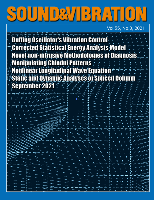
SOUND AND VIBRATION
Exploring the Dynamics of Sound and VibrationSOUND AND VIBRATION, published by TECH SCIENCE PRESS, is a pivotal journal in the fields of Acoustics and Ultrasonics, Mechanical Engineering, and Safety, Risk, Reliability, and Quality. With an ISSN of 1541-0161, this journal has been a reliable source of innovative research and developments from its inception in 1976 through to 2024. Although it currently ranks in the Q4 category on Scopus, it serves as a vital platform for the dissemination of studies focusing on sound and vibration phenomena, contributing to the understanding and advancement of engineering principles. Researchers and professionals are encouraged to utilize this journal to gain insights into critical acoustic applications and mechanical dynamics. While SOUND AND VIBRATION does not operate under an Open Access model, it remains a valuable asset for anyone committed to exploring the various ramifications of sound and vibration in engineering and applied sciences.
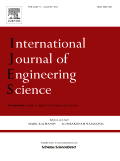
INTERNATIONAL JOURNAL OF ENGINEERING SCIENCE
Pioneering Innovations in Engineering and Materials ScienceInternational Journal of Engineering Science, published by Pergamon-Elsevier Science Ltd in the United Kingdom, stands as a premier platform for pioneering research in the diverse fields of engineering and materials science. Since its inception in 1963, this journal has consistently demonstrated its commitment to advancing academic discourse, maintaining an impressive trajectory that positions it in the Q1 category across multiple engineering disciplines including Mechanical Engineering and Mechanics of Materials as of 2023. With notable Scopus rankings—placing it in the top 5% percentile for Mechanical Engineering and related fields—this journal attracts high-quality, impactful research designed for both industry practitioners and academic scholars. Although it does not currently offer Open Access options, its readership is enriched by comprehensive peer-reviewed articles, fostering a deeper understanding of complex engineering problems and innovative solutions. The International Journal of Engineering Science continues to be an invaluable resource for researchers, professionals, and students committed to pushing the boundaries of knowledge in engineering and materials science.
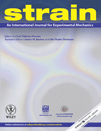
STRAIN
Elevating Research Standards in Mechanical EngineeringSTRAIN is a prestigious peer-reviewed journal published by WILEY, dedicated to advancing the field of mechanical engineering and mechanics of materials. With an ISSN of 0039-2103 and an E-ISSN of 1475-1305, STRAIN has been a pivotal resource for researchers and professionals since its inception in 1965. As of 2023, it holds a commendable categorization in the Q2 quartile rankings for both Mechanical Engineering and Mechanics of Materials, reflecting its significant contribution to the field and ranking in the top percentile of its category. STRAIN aims to disseminate high-quality, innovative research that enhances the understanding of strain phenomena and materials behavior under various conditions. Researchers seeking to publish cutting-edge studies will find a welcoming platform in STRAIN, where they can share their insights with a global audience committed to the evolution of engineering practices. Although it does not offer an Open Access option, its robust editorial standards ensure that all published works adhere to the highest levels of academic integrity and scientific rigor.
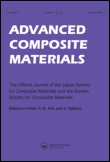
ADVANCED COMPOSITE MATERIALS
Advancing Knowledge in Composite MaterialsADVANCED COMPOSITE MATERIALS, published by Taylor & Francis Ltd, is a leading peer-reviewed journal in the field of materials science, specifically focusing on the innovative development and applications of composite materials. With an ISSN of 0924-3046 and E-ISSN 1568-5519, this journal serves as a vital resource for researchers and professionals worldwide, examining cutting-edge advancements and methodologies in composites, ceramics, and mechanical engineering. Having secured a solid standing in the academic community, it boasts impressive Scopus rankings, such as #185 in Mechanical Engineering with a 72nd percentile and #46 in Ceramics and Composites, emphasizing its relevance and rigor. Although not an open-access publication, its insights are invaluable for those looking to explore, contribute to, and stay abreast of the latest breakthroughs in the field from 1991 through 2024. By targeting critical areas within mechanics and material sciences, the journal continues to foster innovation and scholarly discussion, making it an essential venue for specialists striving to advance the capabilities and applications of composite materials.
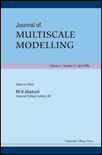
Journal of Multiscale Modelling
Fostering Collaboration in Multiscale ResearchWelcome to the Journal of Multiscale Modelling, a reputable publication dedicated to advancing the fields of Modeling and Simulation and Computer Science Applications. Published by World Scientific Publishing Co Pte Ltd in Singapore, this journal serves as a vital resource for researchers, professionals, and students seeking to explore the intricate relationships between various scales of modeling systems. Since its inception in 2009, the journal has established a pivotal role within the academic community, evidenced by its Q4 ranking in both its respective categories and its interests in contributing to the understanding of complex systems through innovative simulation techniques. With an ISSN of 1756-9737 and an E-ISSN of 1756-9745, the journal encourages submissions that push the boundaries of current knowledge and methodologies. Though currently not open access, articles published in this journal are recognized for their scholarly rigor and innovation, aiming to foster collaboration across disciplines and enhance the practical applications of multiscale modeling techniques in various industries. Join us in exploring the vast potentials of multiscale modeling that lie ahead.
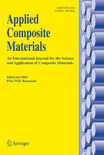
APPLIED COMPOSITE MATERIALS
Transforming Ideas into Composite RealitiesAPPLIED COMPOSITE MATERIALS is a leading peer-reviewed journal published by Springer, dedicated to advancing the field of composite materials and their applications. With an ISSN of 0929-189X and E-ISSN of 1573-4897, this journal serves as an essential resource for researchers, professionals, and students interested in the innovative approaches and technological progress within the realm of composite materials. Based in the Netherlands, APPLIED COMPOSITE MATERIALS is recognized in the 2023 Scopus rankings, holding a prestigious Q2 quartile position in the Ceramics and Composites category, further exemplifying its impact with a rank of #59 out of 127 in materials science. The journal has been at the forefront of composite material research since its inception in 1994 and continues to offer open access to high-quality publications that address both theoretical and practical applications in the field. Researchers can count on this journal to disseminate cutting-edge findings and foster collaboration, driving innovation in composite material development.

Frattura ed Integrita Strutturale-Fracture and Structural Integrity
Unlocking Innovations in Engineering ExcellenceFrattura ed Integrita Strutturale - Fracture and Structural Integrity is a prominent open-access journal published by GRUPPO ITALIANO FRATTURA since 2007, dedicated to advancing the fields of Civil and Structural Engineering, Mechanical Engineering, and Mechanics of Materials. With an E-ISSN of 1971-8993, this journal has established itself as a significant platform for researchers and practitioners in the engineering community, offering an accessible outlet for high-quality research and innovative methodologies. The journal has achieved impressive standings in the Scopus ranks, notably being positioned in the second quartile (Q2) across its relevant categories in 2023, indicating its growing influence and the quality of the research it disseminates. With a publishing scope extending from 2011 to 2024, Frattura ed Integrita Strutturale continues to be an invaluable resource for addressing the mechanics of material integrity and fracture phenomena, inviting contributions that advance understanding and foster multidisciplinary dialogue. By prioritizing open access, the journal ensures that vital research is readily available to a global audience, enhancing collaboration and knowledge sharing among academia and industry alike.
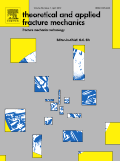
THEORETICAL AND APPLIED FRACTURE MECHANICS
Bridging disciplines through innovative fracture research.THEORETICAL AND APPLIED FRACTURE MECHANICS, published by Elsevier, is a leading journal dedicated to advancing the field of fracture mechanics through rigorous theoretical and experimental research. With an impressive impact, the journal holds a Q1 categorization across multiple disciplines, including Applied Mathematics, Condensed Matter Physics, Materials Science (miscellaneous), and Mechanical Engineering, highlighting its importance in bridging various domains of science and engineering. The journal's ranking within the Scopus database, including 96th percentile in Applied Mathematics and 88th percentile in Mechanical Engineering, underscores its vital contribution to scholarly dialogue and knowledge dissemination. Although it currently does not offer open access, THEORETICAL AND APPLIED FRACTURE MECHANICS maintains a commitment to high-quality publication, aiming to foster interdisciplinary collaboration and innovation in the study of fracture mechanics from 1984 to 2024 and beyond. Researchers, professionals, and students engaged in examining the mechanics of materials will find valuable insights and cutting-edge studies within its pages.